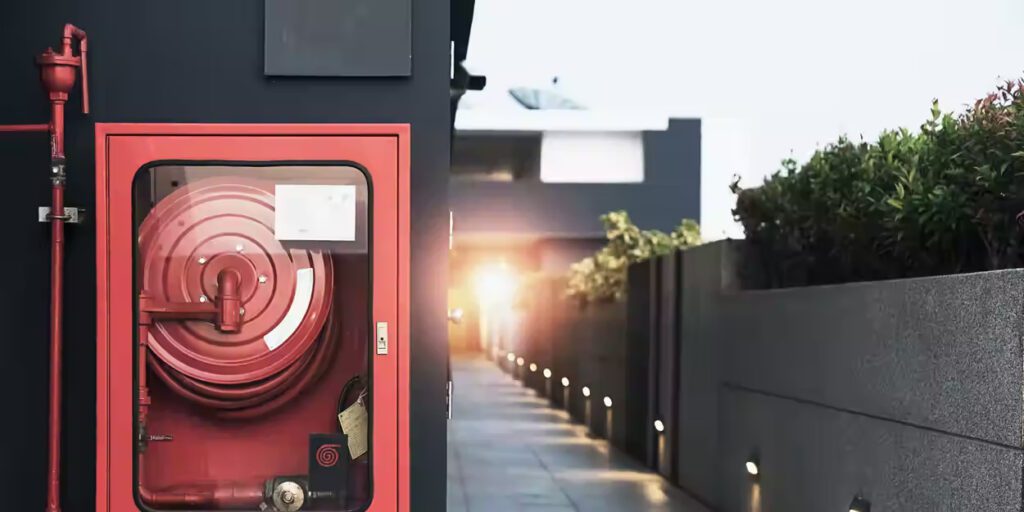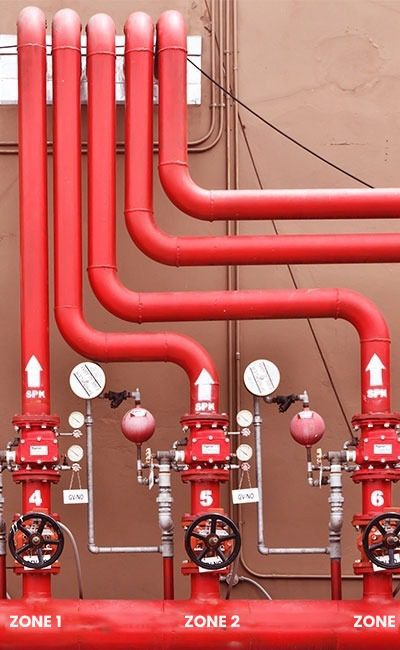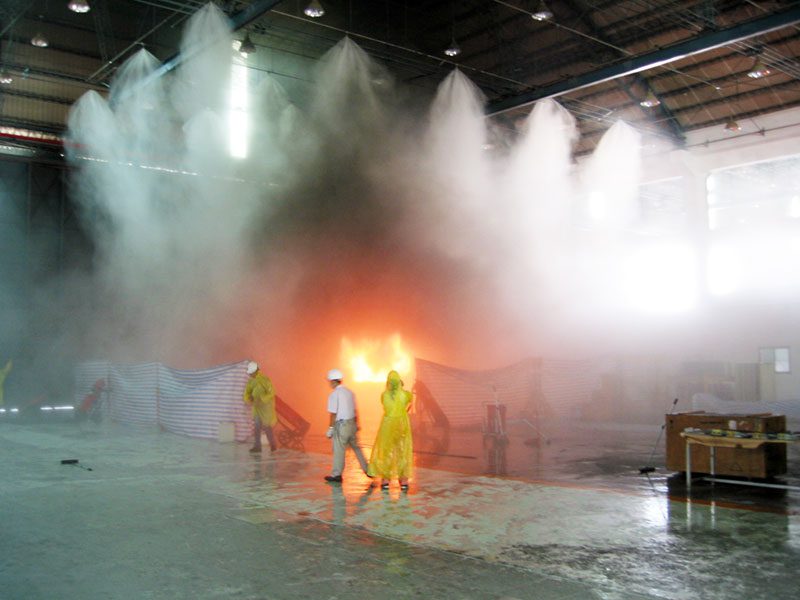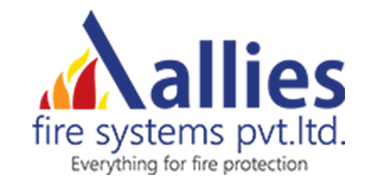Water-based suppression systems dump water onto flames through a typically fixed piping system, using water as a cheap and easily accessible medium. Water based Protection Systems come in 4 different categories. The most appropriate form of system you require will depend on the risk or hazard that has to be protected.
1. Hydrant and Hose Reel System
Systems like standpipes and hoses allow for the hand application of water to building fires. They are typically required in regions without automatic protection and in hard-to-reach places for hose lines from outside hydrants. There are two commonly used standpipe systems.
-Automatic wet riser cum down comer system.
-Automatic down comer system.
A combined sprinkler standpipe system riser may be used efficiently in the majority of structures. The necessary water supply and pressure requirements must be planned in accordance with the applicable code of practice, NBC/TAC/NFPA.
2. Automatic Sprinkler System / Pre Action Sprinkler System
Sprinklers are now by far the most popular and trustworthy automatic fire protection method. Automatic fire detection, alert transmission, and suppression or extinguishment are all features of sprinkler systems. They work only when necessary in the immediate proximity of the fire and are situated in locations where people cannot always be present. The reliability of conventional sprinkler systems is unrivaled because to the careful consideration put into the design, construction, and assembly processes, as well as the stringent approval tests that must be passed.
In a firefighting crisis, time is a key consideration. Automatic sprinklers significantly speed up the firefighting process. Building fires typically begin small. However, if there is enough fuel to feed it, the heat, flame, and smoke levels can rise to the point that human firefighting is significantly hampered, if not rendered completely ineffectual. On the other hand, sprinklers can successfully detect and control fire to reduce property loss.


3. High Velocity and Medium Velocity Water Spray System

The nozzles used in high velocity systems are created specifically to discharge a jet of water at high velocity. The water jet creates a cone of coarse, uniform-density spray that can pass through the flame zone and get to the burning oil’s surface. The oil is divided into particles by the high-velocity spray, and an emulsion is created on the oil’s surface that prevents burning. Along with cooling and smothering effects, this “emulsification” is the main method of putting out the fire. The choice of nozzle specifications, water pressure, and nozzle orientation are crucial to engineering. Transformators, turbines, and combustible liquid dangers are present in the application.
Medium velocity water spray system:
Wherever there are only minor dangers and emulsification from high velocity sprayers is not feasible, medium velocity spray nozzles are chosen. This light mist cools the exposed areas while preventing fires from spreading to nearby plants and buildings. The systems’ components include the piping leading to the nozzles, the deluge valve system, and the fire detection system.

4.Water Mist System
The water mist system made use of the most innovative and cutting-edge nozzles created and authorized for fire protection. This serves as an alternative to heavy density, foam, and gaseous sprinkler systems. While using a pressure that is higher than that of typical sprinkler systems, the water flow is significantly reduced. Less water is used by water mist systems, which also more efficiently reduce pipe sizes, labor costs, and the amount of cleanup and water damage.
5. Foam Water System
Systems for combating fires with foam cover the surface of flammable liquids to smother it and cut off the air’s supply of oxygen. The water in the foam water mixture cools these combustible substances As a provider of solutions, Allies is able to meet your requirements for a variety of foam agents, including chemical, mechanical, protein, fluroprotien, film-forming fluroprotein, aqueous film-forming foam, and AFFF foams that are alcohol resistant, among others.
These systems are typically used for flammable liquids, petroleum, hydrocarbon, various types of oils, and plastics in refineries, fuel depots, aircraft hangars, offshore locations, and ships. The fire spreads quickly, can’t be put out with water alone, and emits hazardous fumes that cause environmental degradation. For you, the Allice team will design, engineer, install, commission, operate, and maintain the foam systems.

The three components of firefighting foam are water, air, and a foam concentration. A foam solution is produced by proportionally combining the concentrate with water. When this solution is combined with air, or inhaled, foam is created. Foam is very fluid and flows easily across liquid surfaces. When left on its own, foam is a stable mass of tiny, air-filled bubbles that has a lower density than water, oil, or gasoline. The most popular technique for foam system applications is balanced pressure proportioning. At the proportioner intake, the water pressure and foam concentrate pressure are matched, allowing the right amount of foam concentrate to be metered into the water stream.
Request an free consultation
Being in this field for more than 27years, we have been exposed to supply erection and maintenance of Fire hydrant, Fire alarm,Gas suppression & Public addressing systems and have groomed extremely skilled work force also. We have enlisted in Government and Public sector organizations which includes CPWD, BSNL, PWD and Military Engineering Service (Kochi), Cochin Shipyard etc are few among them and we are enlisted for the work up to 10crore in CPWD.

